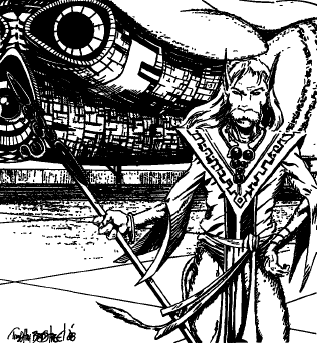Aslan
 Intelligent
major race
evolved from carnivore/pouncers on the world
Kusyu
(
Kilrai'
/
Dark Nebula
1919), situated 135 parsecs from
Capital.
Physically, the typical adult Aslan masses 100 kg, stands upright to a height of 2 m, and is similar in physical needs and preferences to
humaniti.
They have good night vision and a heightened sense of smell. The Aslan hand has three fingers opposing on centrally-placed thumb, and all digits have retractable claws. Under the thumb is a single, highly-specialised dewclaw which folds back jacknife fasion into a horny covering in the base of the thumb and palm.
Intelligent
major race
evolved from carnivore/pouncers on the world
Kusyu
(
Kilrai'
/
Dark Nebula
1919), situated 135 parsecs from
Capital.
Physically, the typical adult Aslan masses 100 kg, stands upright to a height of 2 m, and is similar in physical needs and preferences to
humaniti.
They have good night vision and a heightened sense of smell. The Aslan hand has three fingers opposing on centrally-placed thumb, and all digits have retractable claws. Under the thumb is a single, highly-specialised dewclaw which folds back jacknife fasion into a horny covering in the base of the thumb and palm.
The earliest
Terran
explorers saw in them a vague resemblance to the
Terran
lion, and they have been described as lion-like ever since. There are two sexes, male and female. The most notable difference between the sexes is the male's increased size and larger mane of the male. Females outnumber males by 3:1.
The Aslan are a warrior race, proud, noble, and devoted to those in authority above them. The basic unit of Aslan society is the family (ekho), 2 to 12 Aslan under the leadership of a strong male (tao). Other family members include the leader's wife or wives, children, and various blood relatives of the leader. Several ekho combine under one dominant family to form a pride (ahriy), with the tao' of the dominant family also the leader (aewar) of the pride. A number of ahriy form a clan (huiha), with one dominant pride. Again, the prides owe their loyalty to the leader of the dominant pride (fouheh). Clans, in turn, may owe allegiance to other, stronger clans. Aside from military services and the
Tlaukhu
(ruling council within the
Aslan Hierate),
the clan is the highest socio-political organisation among the Aslan.
A deep-seated instinct causes the Aslan to have an inordinate (from a human standpoint) concern with land. For male Aslan, owning land is a major goal in life. An Aslan's stature is determined by the amount of land he (or her husband) controls, or by the amount of land owned by any higher lord the Aslan may be vassal to. The lowest classes of Aslan are landless, and provide the farmers, labourers, craftsmen, and factory workers. A holder of a large territory will often grant authority over it to vassals (usually sons, brothers, or male relatives by marriage) who administer the land in his name.
The sexes have very different roles in their society. Males (in all but the lowest classes) are mostly concerned with military operations, acquisition of territory, and political affairs. Females are concerned with trade, industry, and the accumulation of knowledge. Upper class males have little concept of money and are literally incapable of functioning in a technological society without aid, so they are thus seldom encountered without the supervision of a wife, mother, or other female relative or employer.
For instance, a typical Aslan mercenary unit will be organised by a wealthy married female, who will then assign its operation (for a share of the proceeds) to an unmarried female relative. The battle commander and most of the troops will be unmarried males (many of them also relatives) hired with the promise of land grants (and the opportunity to gain honour and reputation in combat). Staff, operations, supply and intelligence officers will generally be female.
The extremely deadly nature of any combat between Aslan has led to a rigid, ritualised pattern of behaviour designed to reduce conflict. Aslan are very polite, and while most have learned to be patient with non-Aslan, accidental fights still occur. Disputes between individuals are handled by the patriarchs; disputes between families are handled by the pride leader; disputes between prides are handled by the clan leader.
Aslan have no racial prejudice, but they look upon non-Aslan as tahiwihteakhtau (barbarians) unless they embrace Aslan culture and behave as Aslan. The earliest humans to contact the Aslan (c. -1980 Imperial) felt they resembled
Terran
lions - and the Aslan felt the humans reminded them of the waufuahyu, a hairless primate-like rodent native to caves in the tropical regions of
Kusyu.
(ALIENS-1, 1111;
MT-ENCYC, 1120;
MT-ALIENS2, 1120;
DIGEST-17, 1120)
Return to Top of Page
 Intelligent
major race
evolved from carnivore/pouncers on the world
Kusyu
(
Kilrai'
/
Dark Nebula
1919), situated 135 parsecs from
Capital.
Physically, the typical adult Aslan masses 100 kg, stands upright to a height of 2 m, and is similar in physical needs and preferences to
humaniti.
They have good night vision and a heightened sense of smell. The Aslan hand has three fingers opposing on centrally-placed thumb, and all digits have retractable claws. Under the thumb is a single, highly-specialised dewclaw which folds back jacknife fasion into a horny covering in the base of the thumb and palm.
Intelligent
major race
evolved from carnivore/pouncers on the world
Kusyu
(
Kilrai'
/
Dark Nebula
1919), situated 135 parsecs from
Capital.
Physically, the typical adult Aslan masses 100 kg, stands upright to a height of 2 m, and is similar in physical needs and preferences to
humaniti.
They have good night vision and a heightened sense of smell. The Aslan hand has three fingers opposing on centrally-placed thumb, and all digits have retractable claws. Under the thumb is a single, highly-specialised dewclaw which folds back jacknife fasion into a horny covering in the base of the thumb and palm.